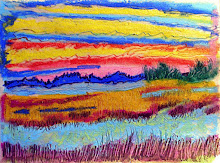Trying to Imagine Birth and Death
©2001 by Don Schaeffer
My sight has always been tall,
pulled wide to make space.
My vision was opened like creation,
first stretched with light
then colored and formed.
My sight was
raised from the
un-stretched, unlighted void,
the space of the dead.
Time is a rack that
holds my life. The
flavors and sounds of my life
are stretched on
pegs of time.
My life was resurrected from
the timeless void: from never, from silence.
The purpose of this brief article is to provide a simple framework and a vocabulary for the way I experience.
If perception is a blank slate then it must have height and width. If it is solid, it must have depth. If it persists, then it must be extended in time. These appear to be basic principles of sensation. The blank space of perception must have extension. Height, width, depth and time are the extensive dimensions.
These dimensions stretch the fabric of perception so that senses can work. Lack of consciousness may be partly describable as a lack of extension, a lack of sensory function.
I assume that every conscious being experiences extension and that all life lives in an extended sensory world. As human beings and vertebrates, our experience stretches existence “spatially” into visual extension, and beyond that, depth. For us, these appear as assumed qualities of the world. Perhaps there is a kind of logic of brain making that make that a priori-ness universal.
Many less “organized” life forms experience just time extension. Time extension may be a simpler form of extension. Thus, a non-visual organism may only know experience in terms of presence or absence, the when, rather than the where of perceptual objects. The experience of spatial extension requires “circuitry” for motion and feedback of motion, or a matrix of locatable, differential sensors, such as eyes.
Objects populate the extended world of perception. An object is a grouping of sensory values that appears different from other sensory values around it. These differences appear along non-extensive or intensive dimensions. Intensive dimensions are the output of sensory organs to the brain, for example, colour, brightness, loudness, pitch, fragrance. A temporally extended object may be duration of pitch or loudness change. A spatially extended object may be a two-dimensional or three-dimensional region of colour or brightness altered from surrounding regions.
Beyond this basic outline, the phenomenology of spatial and temporal extension and intensive dimensions can become very elaborate Secondary and tertiary intensive dimensions derived from the original sensory inputs define “abstract” or “reasoned” objects. Temporally and spatially extended objects can each be “transparent” but in different ways.
Recently, a man from British Columbia was given artificial eyes in an operation performed by a Portuguese doctor. Connection to a digital camera was made through an implant to the visual cortex of his brain. Although he had been completely blind for many years, the man described the new visual sensations as being added to his visual field, not as being a brand new visual field. As a conscious being, the man had always experienced visual extension (height and width), but without meaningful visual objects.
Let’s assume the visual field of the man consisted of hundreds of horizontal and vertical locations. This would represent a matrix of millions of points of sensation. Extensive dimensions would be the horizontal and vertical mapping of the locations. Intensive dimensions would be the color and intensity of the points in the matrix. An object would be a region of the matrix definable as distinct from surrounding regions. The shape of the visual object would be determined by the outline of the variance identified with the object. The shape of visually extended objects could be lasting and stable.
In a temporally extended field, an object would be a period of changed intensive dimension values, such as pitch or loudness or fragrance. The shape of the object would be the pattern of variation. In temporally extended fields, shape can not be permanent or stable. The experience of the temporally extended field is one of a tracing of the present moment through time. Shape is traced by the present moment and then fades as new shapes are experienced. Shape and movement are confounded. Sometimes the experience is one of a moving present and sometimes it is of a shape or form that resides in temporary storage in memory, retaining quasi-stability.
Friday, July 27, 2007
Subscribe to:
Post Comments (Atom)

No comments:
Post a Comment